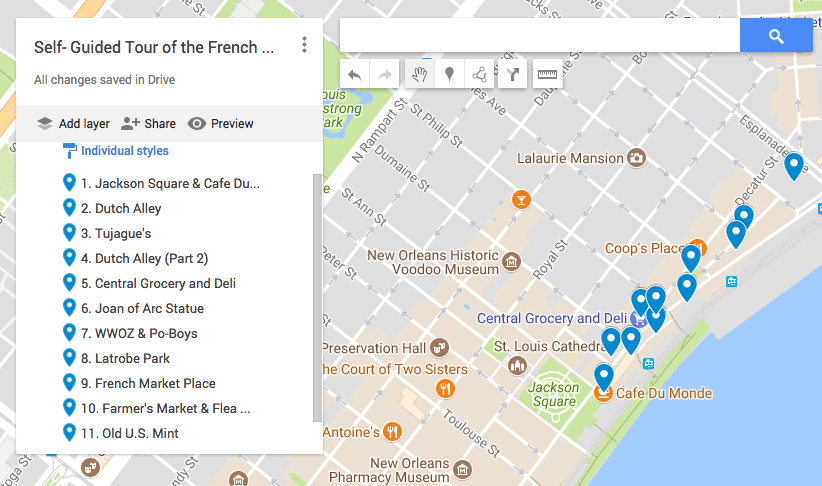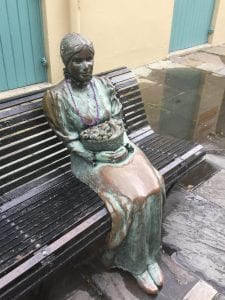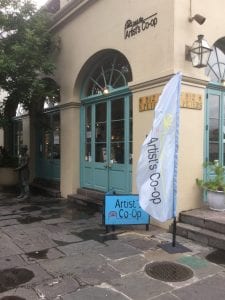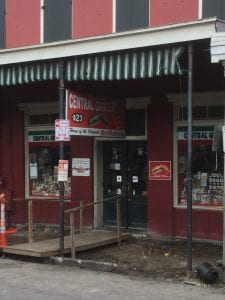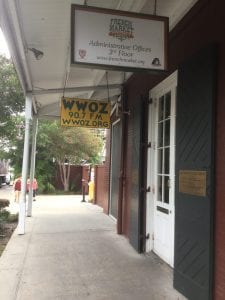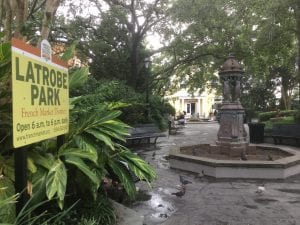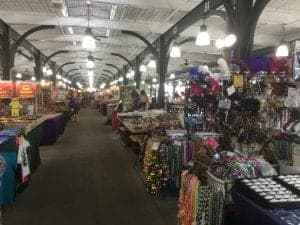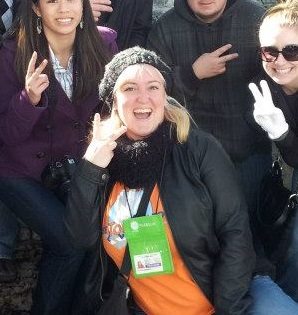This is a self-guided tour of the French Market, including tips to plan your visit as well as recommendations on what to do and where to eat.
The French Market is six blocks of restaurants, shops, a farmer's market, and a flea market.
It is nearly half the length of the French Quarter of New Orleans.
It's a stop on our guided tour of the French Quarter, so let's say we spend a bit of time here.
And, in the clip below, tour guides Andrew and Kayla explain a bit of the history of the market and what you can expect to find here.
And, we have used our experience and expertise as tour guides to help write this post.
We lead thousands of visitors each month through the French Market and answer questions about it on every tour.
We have asked the roughly 50k members of our popular New Orleans Travel Tips Facebook group what they thought of it.
And boy did they respond.
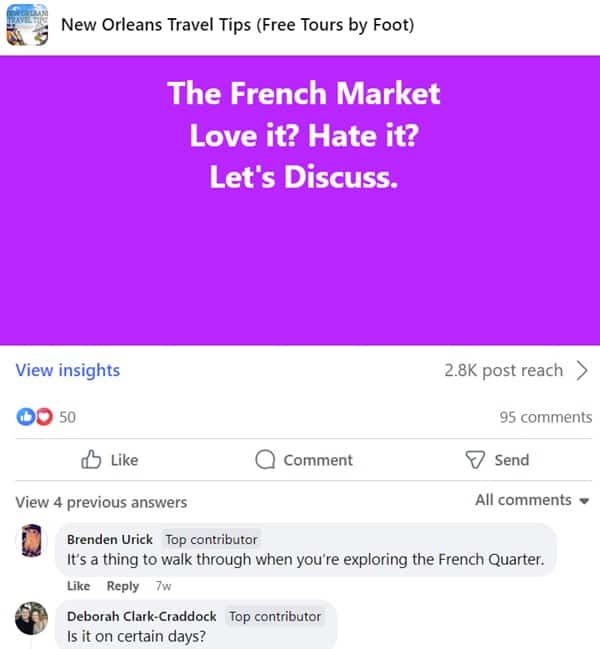
The group consists of locals, such as our tour guides, regular visitors to NOLA, as well as newbies.
There's no need to become a member of the group in order to read the posts, comments, and recommendations.
So, check out the group once you are done reading this post.
- Plan Your Visit
- Things to Do
- Places to Eat
- Self-Guided Tour
- French Quarter Food Tour
- Free Tours by Foot
PLAN YOUR VISIT
Location
Use this link to Google Maps to get directions from your point of departure.
The Riverfront Streetcar runs along the edge of the Market, making it easy to reach from the business district as well; the streetcar goes as far as the Morial Convention Center.
Read our post on using New Orleans' streetcars.
Hours
The French Market is open 365 days a year, the retail shops are open from 10 am–6 pm and the Farmers Market & Flea Market is open from 9 am–6 pm.
THINGS TO DO
The French Market has always been defined by commerce, and there’s barely a spot in its length that doesn’t have something to sell.
In the heart of the French Quarter, on North Peters Street, the Dutch alley artist's co-op bursts with handmade jewelry and printmaking.
Nearby full-service eateries serve BBQ shrimp, sweet pepper crawfish sauce, and vodka, while dessert shops offer Bourbon pecan pie and Loretta’s pralines.
Round off the day with a visit to the historic statues and the Aquarium of the Americas.
Here are a few ideas for enjoyable places to shop, eat, drink, or listen, either in or near the Market.
For background history on the market itself, see below.
Shopping
Most of the French Market consists of retail, mostly souvenir shops.
The flea market, between Governor Nicholls and Barracks Sts. is an open-air market. See the shop directory here.

For a specific focus on local crafts, check out the tax-free Dutch Alley Artists’ Co-op.
For food items to bring home – spices, beignet mix, hot sauce, and so on – visit the farmer’s market.
There are also special events, like the Mardi Gras Mask Market that take place annually on the weekend before Mardi Gras.
Read about Mardi Gras here.
Hear Free Live Music
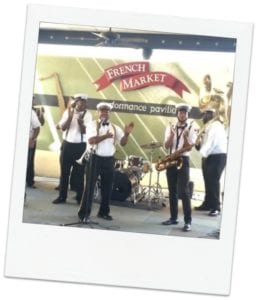
Every Tuesday, there are free (indoor) jazz concerts at the nearby New Orleans Jazz National Park located at 916 N. Peters Street, Dutch Alley.
A listing of live music events in the Market can be found here.
The New Orleans Jazz Museum located a few blocks from the French Market has free performances each week.
Check their calendar to see what's on.
Keep an eye out for informal brass bands that often show up at the flea market.
Two outdoor restaurants in the market – the Gazebo Café and the Market Café – often have live music.
Read our post on where to hear live music in New Orleans.
Get a Drink
There are no bars in the French Market, but the restaurants serve alcohol.
The bar at Tujague’s restaurant is the oldest standing bar in the country and is an excellent spot for a classic New Orleans cocktail.
Read our post "12 New Orleans Drinks You Must Try".
Along the last few blocks of Decatur Street – between Ursulines and Esplanade – is a string of bars like Molly’s at the Market, Coop’s Place to upscale Trinity, Cane, and Table.
TIP: Check out our post on cocktail tours in New Orleans.
Eat Candy!
Be sure to visit the farmer’s market on the block between Ursulines and Gov. Nicholls Streets along French Market Place.
It's a stop included in the self-guided tour below.
One of the highlights of the farmer's market is the array of candy stores. You can try traditional pralines and other southern/Louisiana candy.
Visit Southern Candymakers, Evan’s Creole Candy Factory, Aunt Sally’s Original Pralines, or Loretta’s Authentic Pralines.
For sit-down restaurants and cafes see below.
PLACES TO EAT
These are the restaurants and cafes inside the French Market.
We recommend you read our post on 'must-try' foods of New Orleans to learn about some of the dishes you are likely to find in these restaurants like po'boys, gumbo, and more.
Learn more about the city’s food on one of our New Orleans Food Tours.
Café Du Monde - 800 Decatur Street at St. Ann Street, near Jackson Square.
One of THE places to try in New Orleans. It is a French Market tradition since 1862. Come for the Café au lait and beignets.
Read our post on this famous eatery.
Tujague’s - 823 Decatur St.
Opened in 1856, Tujague’s is the second oldest restaurant in the city (after Antoine’s, which opened in 1840). Though not actually located in the market, it is across the street.
Its classic Creole menu complements a small bar space, renowned for containing the oldest standing bar in the country.
It is featured on our self-guided cocktail tour.
Café Pontalba – 546 Saint Peter Street, on Jackson Square.
Classic New Orleans dishes including seafood po-boys, jambalaya, and etouffee. There is a full-service bar.
The Gazebo Café – 1016 Decatur Street.
Serving specialty cocktails, Cajun and Creole cuisine, seafood, salads, and more. Outdoor seating available and live entertainment featuring jazz.
Market Café – 1000 Decatur Street.
Traditional New Orleans cuisine. Outdoor and indoor dining with live jazz.
PJ’s Coffee of New Orleans – 630 Chartres Street.
Founded in 1978 PJ's was at the forefront of the gourmet coffee scene. Stop in for an espresso, hot-drip coffee, or their unique cold drip.
They also serve muffins, scones, bagels, croissants, and desserts.
Corner Oyster House Bar & Grill – 500 Saint Peter Street, on Jackson Square.
Serving American classics and local specialties including po-boys, burgers, salads, and of course, oysters. They have a full-service bar.
SELF-GUIDED TOUR OF THE FRENCH MARKET
Click here for full interactive map.
1. Jackson Square and Café du Monde
At one time the market’s commercial function extended to Jackson Square, where the fruit was sold in baskets hanging from the fence the way art is sold today.
For more on Jackson Square, see our self-guided tour.
Cafe du Monde has stood at this location since 1862.
The coffee with chicory served at Cafe du Monde and so many other local cafes is a relic of the American Civil War, when New Orleans was cut off from imports and used chicory, the root of the endive plant, to extend the limited supply of coffee.
Beignets, as served at Café du Monde, are a New Orleans riff on a classic French item.
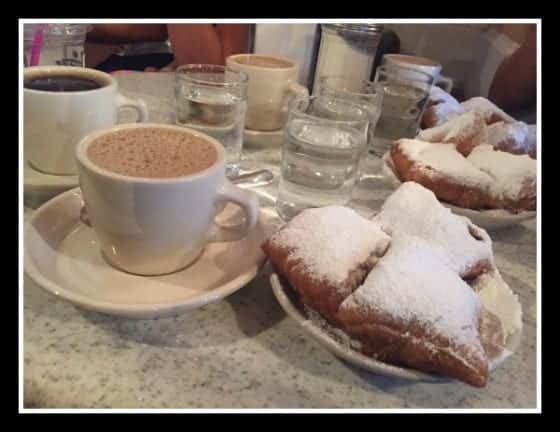
The French Market extends along the row of columns bordering Decatur Street. T
his portion – from Café du Monde down to the next block – is where the first buildings for the market were constructed in 1791, gradually expanding further down.
A hurricane destroyed these buildings in 1812 and none of them remains; however, some of the present structure dates to the replacements built in 1813.
Mainly, the French Market that you see today reflects renovations by the WPA in 1936-7. (For more on the WPA in New Orleans, see our article on City Park.
To continue, step behind the Café (with Jackson Square at your back) and make a left. This will bring you by a window where you can see the beignet-making process firsthand. Continue down this corridor until you reach a statue and mural on your right side.
2. Dutch Alley
Named for Ernest “Dutch” Morial, New Orleans’ first African-American mayor, Dutch Alley extends for a couple of blocks along the quieter side of the French Market.
The floodwall that borders the alley on the right side was added in 1953 – previously, the Market simply looked out onto the Mississippi River, the source of so many of its goods.
The mural on the floodwall, located a short distance past Café du Monde, depicts artist Shakor’s vision of the French Market as it was for much of the 19th century.
The river is visible on the right side, along with a meat vendor; on the left, you can see vendors selling produce, coffee, and calas – rice fritters that can still be found on a few New Orleans menus, particularly that of the Old Coffee Pot Restaurant in the French Quarter.
(Calas are somewhat like beignets, but rice-based and derived from African rather than French cuisine.)
The cloth headscarves worn by the three women in the foreground are called tignons. Beginning in 1786, free African-descended women in New Orleans were legally required to wear tignons.
Pre-American New Orleans saw many enslaved people purchase their own freedom, often through selling coffee or calas.
The figures in the painting include at far left, Edgar Degas, the painter, who visited and painted New Orleans; Rose Nicaud (coffee vendor), a woman famous for achieving freedom from slavery as a coffee seller; to the right of her, Marie Laveau, the renowned priestess of the voodoo religion; on the carriage, Micaela Almonaster, Baroness de Pontalba, who constructed much of Jackson Square, and Jacques the Butcher, a French Market archetype who you’ll see in statue form further down Dutch Alley.
With the mural at your back, proceed through the passage onto the Decatur Street side of the Market and look at Tujague’s across the street.
3. Tujague’s - 823 Decatur St.
Opened in 1856, Tujague’s is the second oldest restaurant in the city (after Antoine’s, which opened in 1840).
Its classic Creole menu complements a small bar space, renowned for containing the oldest standing bar in the country.
Tujague was the inventor of the grasshopper – a brandy and dairy cocktail, flavored with mint, coined just before Prohibition.
The restaurant also claims a more formidable invention: brunch. In the decades following its opening, the story goes, one of its owners, Madame Begue, began to serve a late breakfast for the butchers working across the street in the French Market.
While this accommodated the schedules of the working class, it coincidentally also met the demands of late-sleeping travelers coming to visit New Orleans for the 1884 World Cotton Exposition.
Today, brunch is served at Tujague’s from 10:00 am-2:30 pm Saturday and Sunday, but lunch and dinner are options, too.
Continue to the right until you reach the intersection of Decatur and Dumaine, then look to the right into Dutch Alley.
4. Dutch Alley (Part 2)
At the intersection of Decatur and Dumaine, you’ll find Evan’s Creole Candy Factory – one of your numerous choices for trying out a praline.
Pralines are based on a French candy involving almonds – nonexistent in colonial Louisiana and so substituted with the native pecan.
Along with coffee and calas, it was another means of making a living for enslaved and free African-descended women in antebellum New Orleans.
Besides the pecans, another key locally grown ingredient was sugar.
Planters discovered how to grow sugar in Louisiana’s climate of occasional freezes late in the 18th century and the industry quickly skyrocketed.
Large numbers of women with baskets of pralines would once have walked through the market, singing about their wares.
Opposite Dutch Alley from Evan’s Creole Candy Factory, you’ll see the Dutch Alley Artists’ Co-op. Everything sold here is locally made, whereas many of the souvenirs in town are imported.
Because of laws about locally made art, no tax is charged for sales at this location.
The floodwall opens here onto the Mississippi River levee, allowing a chance to walk onto the riverfront if you like.
From here, cross Decatur Street and turn right, continuing until you reach Central Grocery.
5. Central Grocery, 923 Decatur St.
Central Grocery, an Italian grocery, and restaurant dates to the early 20th century, when the riverfront of the French Quarter was Little Palermo.
It was home to Sicilian immigrants who poured into the decaying post-Civil War French Quarter and provided the scenery that artists and writers in the 1920s, including William Faulkner, would see as romantic squalor.
While many Sicilian arrivals became longshoremen, others entered into culinary professions – the French Quarter was once home to numerous bakeries and pasta factories.
For the most part, Italian New Orleans today lies in the suburb of Metairie, but a few relics – particularly the restaurants Napoleon House and Central Grocery – remain.
Central Grocery is best known for its invention of the muffuletta sandwich, an enormous round sandwich of olive salad, cured meats, and cheese, traditionally served cold but sometimes today found hot.
As the creator of the sandwich, Central Grocery is a major destination for it today. A quarter muffuletta is a substantial snack, while a half is a meal for most people.
From here, look across the street at the bronze equestrian statue.
6. Joan of Arc Statue
This gilded bronze statue depicts Jeanne d’Arc – the Maid of Orleans.
It is a copy of a statue located in Paris, made in 1880 by Emmanuel Fremiet, and gifted by France to New Orleans in 1972.
Previously located at the end of Canal Street near the river, Joan was displaced by the construction of Harrah’s casino and relocated to the French Market.
You can find another much smaller statue of St. Joan inside St. Louis Cathedral.
From here, continue down Decatur Street to the intersection with St. Philip. Cross Decatur to the right and you’ll arrive immediately at the intersection with N. Peters St. Look across and to the left to spot the hanging sign for WWOZ.
7. WWOZ and Po-Boys
The innocuous portion of the French Market just across N. Peters St. from the statue of Joan of Arc contains the headquarters of WWOZ, a local radio station, as well as the place where the po-boy sandwich was invented.
WWOZ is a listener-supported jazz and heritage radio station broadcast in New Orleans on 90.7 FM and streamed worldwide via their website.
The station has moved several times since its founding in 1980 and arrived here in the French Market after Hurricane Katrina.
Besides 24-hour broadcasts of local-flavor and world music, WWOZ produces live events, interviews, podcasts, and a daily, citywide calendar of live music called the WWOZ Livewire, which can be found here.
This area was also the one-time home of Martin Brothers’ Coffee Stand and Restaurant, which opened in 1922.
Its founders had previously worked as streetcar conductors and so were sympathetic when streetcar workers initiated a strike in 1929.
This strike was met with enormous public sympathy and donations, one of which was a free lunch to union members at Martin Brothers.
“Here comes another poor boy” became the phrase used to call for a union sandwich – at the time, a simple pairing of roast beef debris with the local variation on French bread.
Continue down the Market, past the Market Café and Gazebo Café, until you reach Latrobe Park.
8. Latrobe Park
This small park is named for Benjamin Latrobe, an English architect who, in addition to other notable works (including the US Capitol building in Washington, DC), designed New Orleans’ first municipal waterworks.
As the French Market expanded, the waterworks came to be neighbored by an area designated for vegetable sellers, and it was eventually displaced completely.
Continue forward until you reach Ursulines Street and the beginning of French Market Place.
9. French Market Place/Gallatin Street
Before it was French Market Place, this tiny two-block stretch was Gallatin Street.
A port city needs a waterfront and a market, but it also tends to have a vice district to entertain visiting sailors.
New Orleans had several, and Gallatin Street seems to have been the scariest.
The eagerness of police to avoid it makes for a dearth of hard records about what happened there, but legend furnishes stories aplenty: customers knocked out and pressed into service aboard ships; a bouncer with a missing arm replaced with a ball and chain; madams who could get away with stabbing customers as long as they didn’t chase them off of Gallatin Street first.
The conditions on Gallatin Street were among the factors that drove the city to legislate a vice district in 1897 that would come to be called Storyville.
Closed in 1917 and largely demolished since, Storyville nonetheless remains famous as the neighborhood that made jazz music a profession for many early greats like Jelly Roll Morton and even Louis Armstrong.
In 1935, after a few quiet decades, the last of Gallatin Street’s lingering reputation was abolished through a name change and the demolition of all the buildings on one side, clearing the way for the farmer’s market and flea market located here today.
The buildings opposite the market remain to stimulate the imagination.
Proceed through the arch that says “French Market” into the farmer’s market.
10. Farmer’s Market and Flea Market
The farmer’s market – more a strip of restaurants than a farmer’s market – runs for a block, followed by the flea market, another block hosting numerous sellers operating from individual tables.
Offerings in the farmer’s market vary by time of year but generally include some version of the most classic New Orleans items (po-boys, gumbo, jambalaya, local seafood, muffuletta sandwiches, pralines).
Look here for a full list of eateries in the farmer’s market.
Among these, the Organic Banana is known for its spiked smoothies; Meals from the Heart Café is one of the friendliest choices in the neighborhood for vegans, vegetarians, and generally health-conscious eaters; Loretta’s Authentic Pralines has coined a praline beignet; and Alberto’s Cheese and Wine Bistro makes one of the best hot muffulettas you can find.
The flea market includes vendors from all over the world and from many different business cultures; for this reason, it’s a smart idea to come ready to haggle, but not all vendors will welcome it.
From the end of the flea market, you can see a large red building, the Old US Mint.
11. New Orleans Jazz Museum and the Old US Mint
The Old US Mint, built in 1835, is the only building to have produced both the United States and Confederate currency.
It also briefly served as housing for Confederate troops during the Civil War, until the occupation of Federal Forces in 1862.
In 1879, after Reconstruction, minting resumed until 1909, when it was decommissioned.
Today, it houses the New Orleans Jazz Museum.
From here, you have several options for where to proceed. Just on the other side of the Old US Mint is the beginning of Frenchmen Street, two blocks of bars and restaurants hosting live music starting as early as noon.
Other restaurants and bars, mostly without music, lie along Decatur Street, which is a half-block away, parallel with the flea market and farmer’s market.
In the opposite direction is the riverfront, which can provide a more peaceful walk back toward the middle of the French Quarter, or the Riverfront Streetcar, which can carry you as far as the Morial Convention Center for $1.25 per person.
HISTORY OF THE FRENCH MARKET
The French Market has been a destination for New Orleans visitors for over two centuries.
Besides offering food, souvenirs, and local color, the French Market is also the oldest market in the country and arguably the oldest man-made feature of New Orleans.
Long before the founding of the city in 1718, the site of the market was home to a Native American trading post.
In the first half of the nineteenth century, the French Market lay along one of the busiest ports in the world.
That era’s visitors left behind many accounts of the sensory overload the market delivered.
Every kind of New Orleans resident sold wares there, from new Sicilian immigrants selling fruit to Choctaw women sitting on palmetto mats selling herbs and baskets, to free women of color selling coffee.
Vendors shouted or sang about their goods in many languages, fighting for attention.
19th-century accounts also dwell on the market’s filth.
John James Audubon, the artist famous for painting American birds, explored the market in 1821 looking for fowl he could use as models, and was surprised to find, among the more typical game poultry, a large dead owl for sale; afterward, he described the French Market as “the dirtiest place in all the cities of the United States.”

Both sadly and fortunately, only a small portion of the market today at all suggests this former intensity.
The market’s history, however, is still evident in its essential purpose, its art, and its layout.
Different portions of the 19th-century market were designated for selling meat, fruits, vegetables, and dry goods, as well as specific areas for black and Native American vendors; the divisions you can see today – retail here, restaurants there, flea market there – reflect these old boundaries.
And while today’s buildings were primarily constructed by the WPA in 1936-7, some of the 19th-century structures are still present.
Even beyond the French Quarter, small markets were once fixtures and organizing points for many New Orleans neighborhoods.
Some are gone without a trace – one that ran along the median of Poydras Street, for example, now the hub of the city’s skyscrapers – while others, like St. Roch Market, still function in some form.
Of all of them, the French Market has been the most durable.
At the French Market, you can enjoy a variety of options, such as handmade crafts, fresh food, accessories, and speciality foods.
Do you need cash to shop at French Market?
Yes, you do need to keep cash for your convenience. But many traders, craftsmen, and worldly artists accept both cash and cards for their goods, making it a more convenient shopping experience.
Is the French Market the same as the French Quarter?
While the French Market is a vibrant part of it, it's not the same as the French Quarter. The French Quarter is a historic area known for its full-service eateries, attractions, and the iconic French Quarter Hotel. Meanwhile, the French Market is a specific location within this district that features an array of vendors, homegrown spices, local produce, and performance tents.
RELATED POSTS






